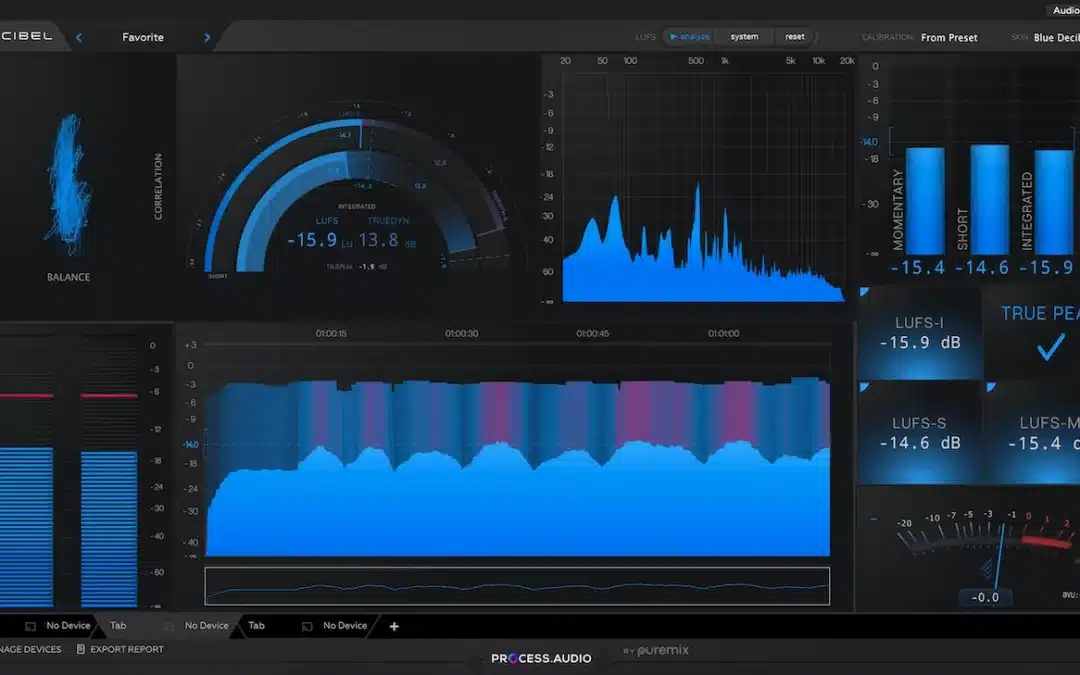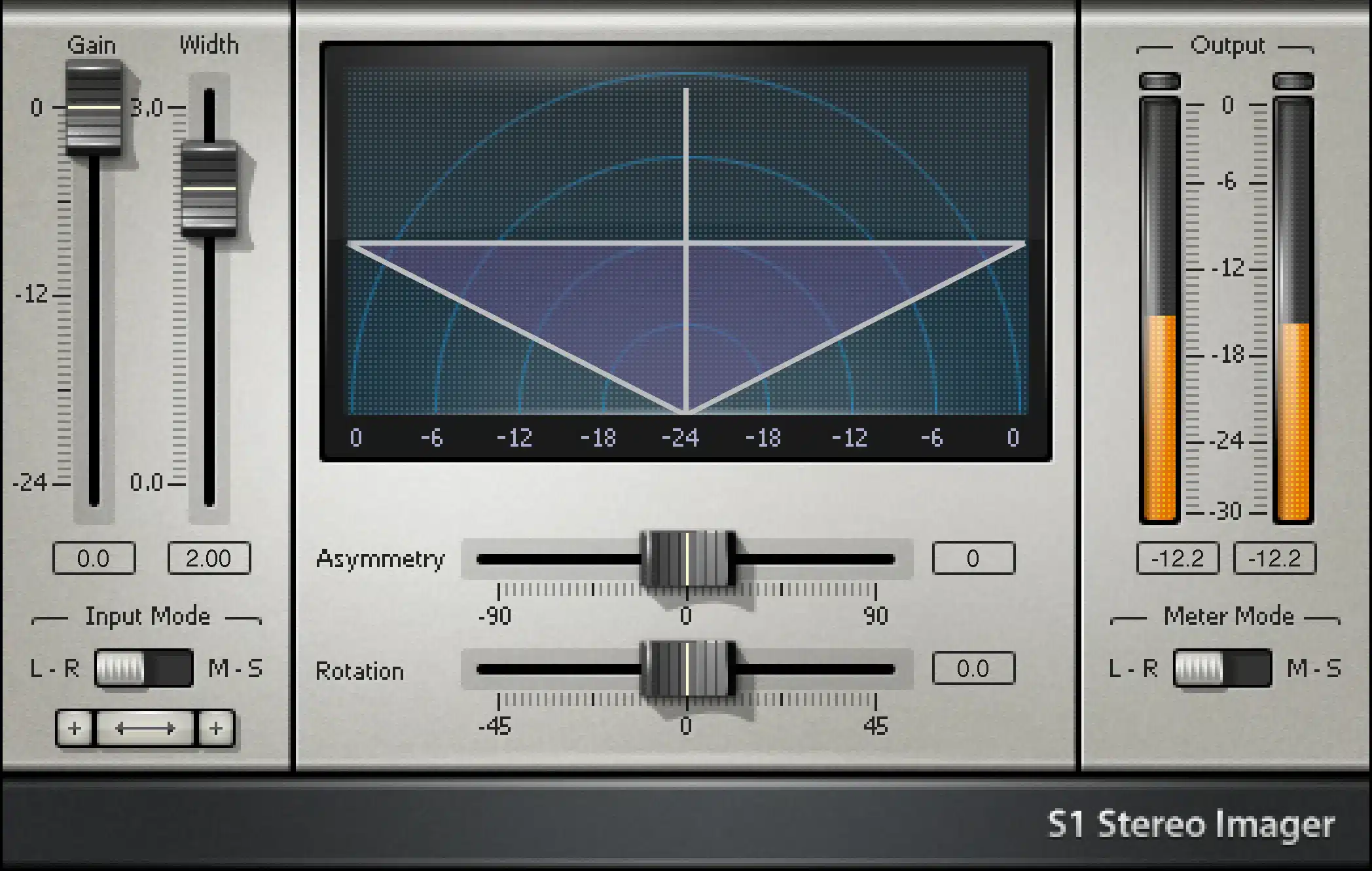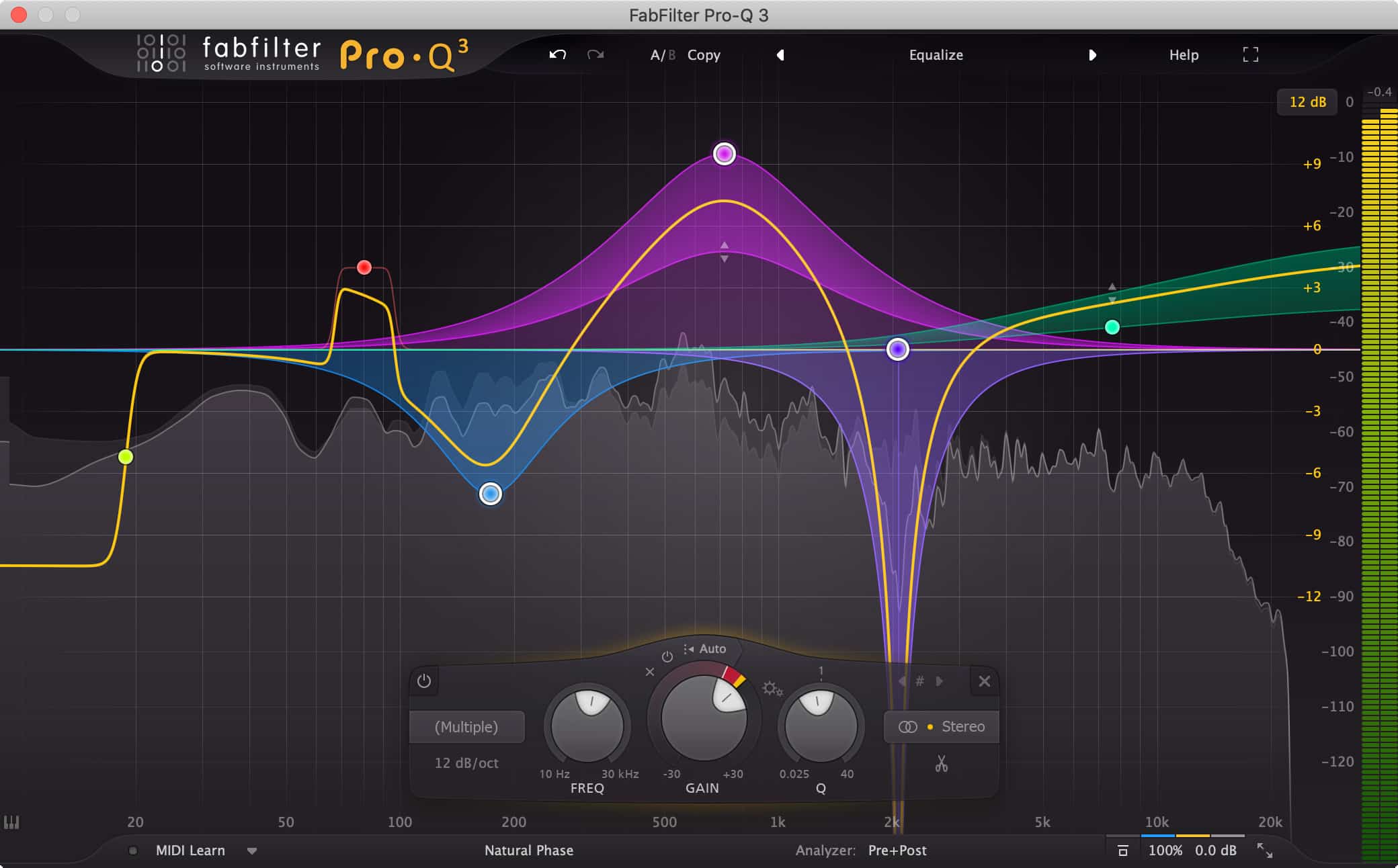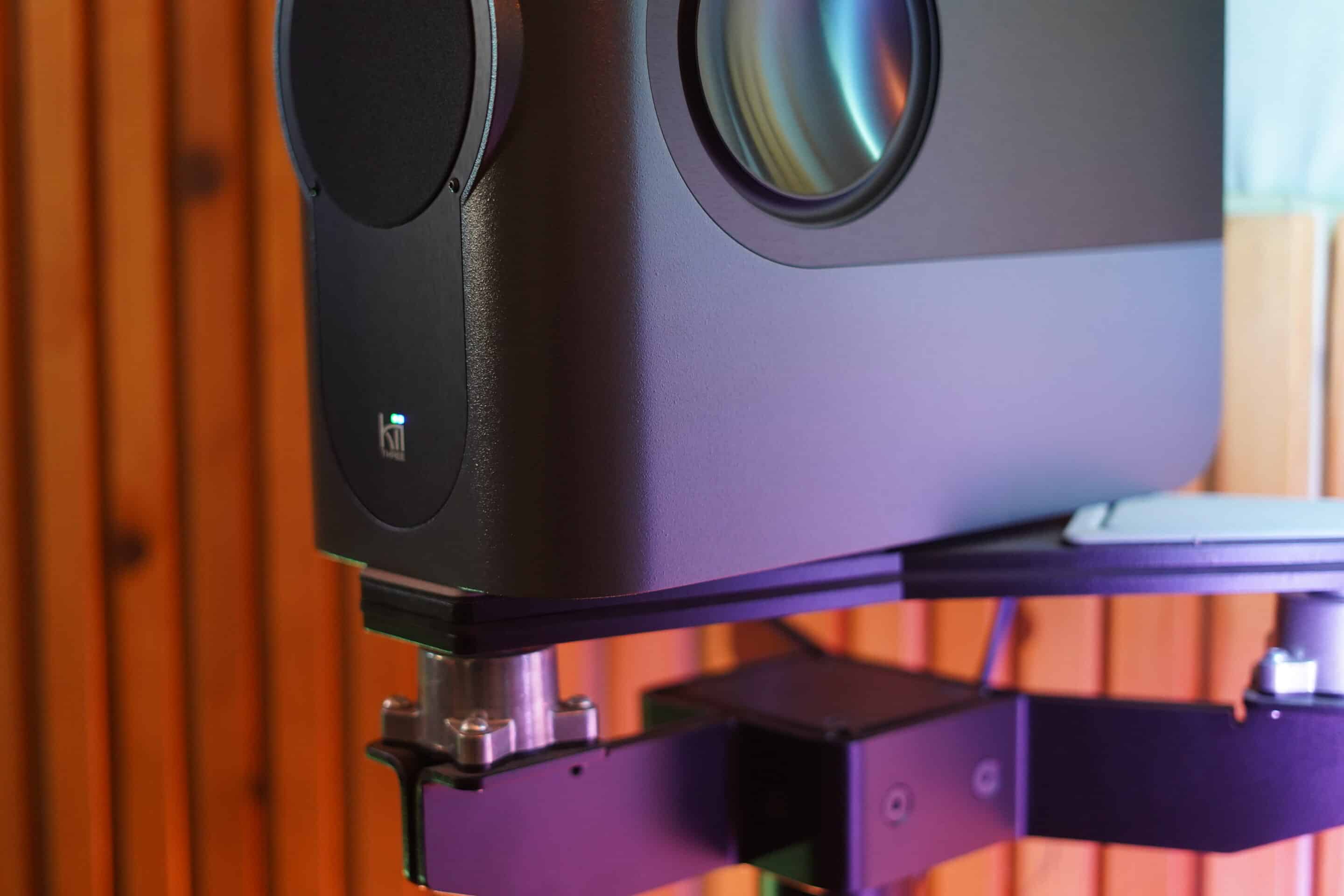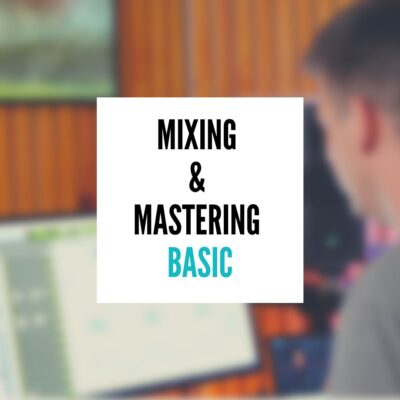As a seasoned mastering engineer, I’ve spent countless hours refining tracks to meet the industry’s rigorous standards. In the realm of audio mastering, one metric has become increasingly important: LUFS in audio. LUFS, or Loudness Units Full Scale, serve as a pivotal yardstick for mastering engineers like myself, ensuring audio volume levels are both consistent and optimized for listener enjoyment.
This concept might seem esoteric, but it’s my mission to demystify it and explain why understanding LUFS is so crucial. This article will navigate through the nuances of LUFS and their profound impact on audio mastering. Whether you’re also in the industry or simply passionate about how music reaches its final form, recognizing the significance of LUFS will elevate your comprehension of what it takes to achieve masterful audio quality.
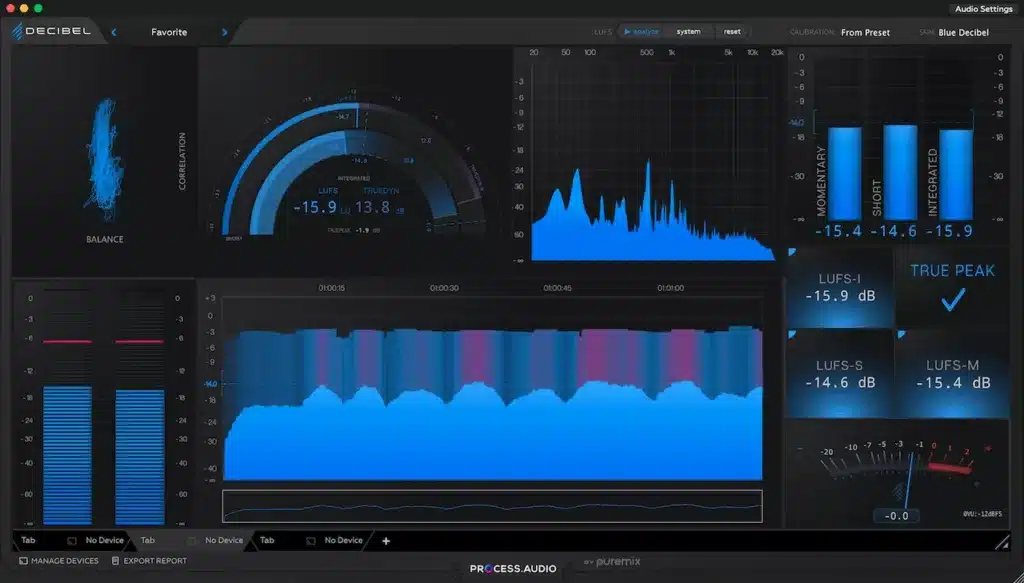
I use Decibel as my primary LUFS Meter
Key Takeaways
- LUFS are essential for maintaining consistent audio volume levels in mastering.
- Grasping LUFS is fundamental for mastering engineers aiming for industry standards.
- Understanding LUFS can help navigate complex audio mastering processes.
- Knowledge of LUFS directly impacts the final audio quality enjoyed by listeners.
- Acknowledging the role of LUFS is crucial in the era of streaming and digital music consumption.
The Importance of Loudness in Mastering
As a professional in the field of audio mastering, I’ve seen firsthand the profound influence mastering loudness has on the overall listener experience. Perfecting the loudness of a track isn’t just a technical necessity; it’s an artistic imperative that affects how listeners emotionally connect with the music. Achieving the right balance can mean the difference between a song that resonates with its audience and one that falls flat.
How Loudness Impacts Listener Experience
The human ear is a complex organ, capable of detecting a wide range of sounds, from the subtle to the overpowering. Mastering loudness ensures that the nuance and power of a piece are transmitted effectively to the listener. Through careful control of audio levels, mastering creates a final product that delivers the intended impact—whether it’s the soft whisper of an acoustic piece or the compelling drive of a rock anthem.
Loudness shapes the mood and energy of a track and plays into the psychological aspect of how we perceive and enjoy music. It’s about more than just volume; it’s about clarity and the full realization of an artist’s vision. When done right, it has the power to bring the listener closer to the core of the musical experience.
The Evolution of Loudness Standards
The journey to current audio loudness standards is a storied one, rooted in the desire to preserve the dynamic range while meeting the demands of various playback systems. The past few decades witnessed the ‘loudness wars,’ where an escalation of volume often led to a reduction in audio fidelity. The competitive drive to produce the loudest track often resulted in a sonic arms race to the detriment of the listener’s experience.
Thankfully, the introduction of objective measurements and standards for audio loudness, such as those implemented by the International Telecommunication Union (ITU), has shifted the industry’s approach. These guidelines have been essential in protecting the dynamic range and ensuring that our listening experiences remain high-quality across media formats and platforms. They’ve allowed engineers like me to focus on mastering for balance and impact, without the pressure to sacrifice quality for perceived loudness.
Understanding and abiding by these audio loudness standards is now a critical skill for every mastering engineer, ensuring that music is not just heard, but truly experienced by listeners worldwide.
Decoding the Term: What Are LUFS
As a mastering engineer, my clients often ask me, “what is LUFS?” In the simplest terms, LUFS stands for Loudness Units Full Scale. It’s a standardized measurement used to gauge the perceived loudness of audio material. This term becomes especially significant in an era where evenness in audio playback across various platforms is imperative. To offer a loudness units full scale explanation, it’s important to consider that this unit is relative to a digital audio system’s maximum level.
Imagine you’re painting a picture, but instead of colors, you’re using sounds. Just as a painter controls the intensity of color, in audio mastering, you control the intensity of sound. LUFS help to ensure that your “audio painting” has the right balance so it can be appreciated on any gallery wall, be it a car stereo or a high-end sound system.
Let’s use an analogy to further demystify the concept. Think of LUFS as measuring the weight of a suitcase. While pounds or kilograms tell you how heavy the suitcase is, LUFS tell you how loud an audio track is over time. And similar to how an airline has a weight limit for luggage, streaming services have loudness standards that your audio needs to meet. This analogy helps my clients to comprehend why hitting the optimal LUFS number is crucial for their tracks to sound consistent across different platforms and devices.
- Loudness perception is complex and hinges on duration, frequency, and audio content
- LUFS considers these aspects to provide an averaged measurement, analogous to how our ears perceive loudness
- LUFS can help avoid the pitfalls of the ‘loudness wars’ by facilitating dynamic and consistent mastering
In mastering, the goal is to ensure that the final product has the desired sonic impact. From quiet, intimate passages to booming crescendos, LUFS enable me to craft the audio landscape so that it translates effectively across all listening scenarios. Think of LUFS as the common language that allows us to maintain the integrity and intent behind every note and beat in the vast world of sound.
The Technical Side of LUFS
Deciphering the details of LUFS measurement is imperative for audio professionals aiming to produce well-balanced mixes. By understanding the nuances between LUFS and other audio measurement units, such as decibels (dB), I can ensure my audio work meets industry standards and provides listeners with the best experience.
Understanding LUFS Measurement
LUFS, or Loudness Units relative to Full Scale, is a standard that aims to gauge the perceived loudness of audio material. This measurement is crucial because it reflects how human ears interpret sound levels, rather than just the electrical levels that dB measurements provide. The LUFS standard encompasses three key readings: short-term, momentary, and integrated LUFS. Short-term LUFS reflect loudness over a three-second window, ideal for catching dynamic changes in a mix. Momentary LUFS capture peaks and valleys in loudness as brief as 400 milliseconds, while Integrated LUFS offer an overall loudness reading for an entire track, proving vital for consistency across an album or playlist.
Difference Between LUFS and dB
Although LUFS and dB might seem similar, they cater to different aspects of sound measurement. Decibels quantify the intensity of sound—purely a physical measurement. In contrast, LUFS consider how sound pressure is perceived by the human ear, which is why it’s become an industry-standard for broadcasting, music streaming, and more. Understanding LUFS vs dB is pivotal for any audio project, ensuring compatibility with loudness normalization standards on various platforms.
Take for instance, when mastering a track, I wouldn’t solely rely on dB levels to optimize for streaming services like Spotify or Apple Music. Instead, I use LUFS measurement tools to guarantee my audio meets the specific loudness criteria these platforms enforce.
| Measurement Unit | Purpose | Relevance to Mastering |
|---|---|---|
| dB (Decibels) | Quantify sound intensity | Setting recording levels, avoiding clipping |
| LUFS (Loudness Units Full Scale) | Measure perceived loudness | Loudness normalizing, broadcasting standards |
The in-depth knowledge of these audio measurement units provides for precision in the mastering process, where a meticulous balance of technicality and artistry leads to aurally gratifying results.
Why LUFS Matter for Modern Mastering
In the continuously evolving landscape of audio production, mastering engineers are faced with new challenges as they adapt to the intricacies of modern mastering. With the advent of digital streaming, the loudness normalization that services like Spotify and Apple Music employ has a pivotal role in determining how a track ultimately sounds to the listener.
The Role of Streaming Services
Living in the age of streaming, listeners often shuffle through songs from different albums and artists, expecting a consistent listening experience. Streaming services loudness standards have therefore been implemented to ensure that tracks play back at a similar loudness level. This demands a shift in mastering techniques, where mastering to a target loudness level compatible with streaming platforms becomes crucial for a harmonious listening experience across multiple songs and genres.
Loudness Normalization Explained
Loudness normalization is a process implemented by streaming platforms to match the volume levels of tracks so that listeners don’t have to reach for the volume knob between songs. This is achieved through measuring the loudness of a song using an algorithmic loudness standard like LUFS. As such, mastering with loudness normalization in mind ensures tracks don’t only sound good in isolation but also when streamed back-to-back with countless others.
| Streaming Service | Target Loudness Level (LUFS) | Loudness Normalization Applied |
|---|---|---|
| Spotify | -14 LUFS | Yes |
| Apple Music | -16 LUFS | Yes |
| YouTube | -13 to -15 LUFS | Yes |
| Tidal | -14 LUFS | Yes |
| Amazon Music | -14 LUFS | Yes |
Mastering engineers must now regard these normalization protocols as a vital aspect of their workflow, to preserve both the artist’s vision and the integrity of the music when it reaches the audience—ultimately defining modern mastering as a technical art that takes place in a broader context of global consumption.
How Many LUFS Should My Master Be
As a mastering engineer, I’m often asked about the optimal LUFS levels for different platforms to maintain audio dynamics while ensuring the final product is competitive and clear. Markedly, mastering for platforms such as Spotify, Apple Music, and YouTube requires a nuanced approach to achieve balance and meet platform standards. However, even with the standards I still master music much louder than the standard because the sound of pop music is a heavy limited sound.
Optimal LUFS Levels for Different Platforms
Each listening platform has its own preferred LUFS level, and adhering to these recommendations can make a significant difference in how your music is perceived and heard. Here’s a snapshot of the optimal ranges:
| Platform | Optimal LUFS Level | Notes |
|---|---|---|
| Spotify | -14 LUFS | Spotify’s normalization can turn down tracks mastered louder than -14 LUFS. |
| Apple Music | -16 LUFS | Apple prefers a slightly quieter master to preserve dynamic range. |
| YouTube | -14 to -16 LUFS | YouTube uses a complex algorithm, but staying within this range yields good results. |
| Alexa | -14 LUFS | For voice-controlled environments, clarity at -14 LUFS is key. |
Dynamics vs. Loudness: Finding Balance
One of the fundamental challenges in this digital age is striking a balance between achieving competitive loudness and preserving the dynamic range. The gripping power of a track often lies in its audio dynamics, and maximizing loudness can sometimes lead to a flattening of these crucial elements.
- Loudness needs to be optimal, not maximal; pushing LUFS to the extreme often reduces the impact of emotional dynamics in the music.
- Respecting the dynamic range allows for the expressiveness of your music to shine through, conveying the intended emotions and nuances.
Ultimately, mastering with both platform optimal LUFS levels and audio dynamics in mind delivers a master that not only translates well across listening environments but also retains the artistic intent and audio quality of the recording.
Using a LUFS Meter for Precision
As an audio professional, it’s paramount to measure and analyze loudness to achieve the best result in any mastering workflow. Incorporating LUFS meters into such processes allows for precise control over sound levels, ensuring that the audio product meets industry standards and the expected listening experience. On top of that, understanding LUFS meter usage and choosing the right tools can make all the difference in your final output.
Types of LUFS Meters
Different LUFS meters come with unique features that cater to various aspects of audio mastering. Some offer detailed visual feedback, while others prioritize simplicity and ease of use. The market boasts a wide range of options, from software plug-ins to standalone hardware units, each designed to help you navigate the complex landscape of loudness normalization.
Integrating LUFS Meters into Your Workflow
Finding the right LUFS meter and incorporating it into your mastering workflow is essential for maintaining consistency in your projects. The goal is to choose a meter that not only provides accurate readings but also complements your working style. Let’s dig into some of the top contenders and see how they fare against each other:
| LUFS Meter | Key Features | Usability | Compatibility |
|---|---|---|---|
| Youlean Loudness Meter | Comprehensive visual feedback, historical loudness graph | User-friendly interface | Mac and Windows, VST, AU, AAX |
| iZotope Insight 2 | Advanced metering suite, spectral loudness, and history | Flexible and scalable interface | Mac and Windows, VST, AU, AAX |
| Waves WLM Plus Loudness Meter | Real-time loudness metering, True Peak output | Efficient workflow integration | Mac and Windows, VST, AU, AAX, SoundGrid |
| TC Electronic LM2n | Precise radar display, True Peak limiting | Streamlined operations | Mac and Windows, VST, AU |
| Orban Loudness Meter | Free software, logging facility, time-code | Straightforward functionality for live monitoring | Mac and Windows, Standalone application |
Mastering with precision requires the right set of tools. I’ve found that using a dedicated LUFS meter, amongst different LUFS meters options, has greatly improved my mastery over audio dynamics and loudness. The real-time feedback and historical analysis help in creating masters that stand up consistently across all platforms.
Remember, the goal is not only to meet the target LUFS level but to maintain the sonic integrity of your work. A good LUFS meter is indispensable in striking that perfect balance.
What LUFS Should I Master To
Mastering level targets often present a challenge for audio engineers, particularly when asking, “What LUFS should I master to?” As an accomplished mastering engineer, I’ve learned that the ‘one-size-fits-all’ approach doesn’t apply here. Different genres and platforms may require distinct LUFS levels to ensure the best listener experience. Below, you’ll find insights derived from industry standards and my own professional experience that aim to guide you through setting your mastering levels with confidence.
The recommended LUFS (Loudness Units Full Scale) for mastering audio tracks can vary, but generally, most streaming services have converged on a target of around -14 LUFS for integrated loudness. This target ensures that your track maintains its quality after loudness normalization is applied, avoiding the detrimental effects of being either too loud or too quiet. However, it’s important not to take this number as an absolute. Certain musical styles may benefit from slight deviations to preserve their dynamic range or punchiness. However, I still master music much louder, because -7 to -8 LUFS is still the way people want to hear the music. The limited sound is still something people like. I assume this will change as time goes on.
Mastering isn’t just about hitting the numbers; it’s about understanding the psychoacoustic impact of loudness on the listener and maintaining the integrity of the artistic vision.
Here is a simple, yet insightful table of LUFS targets that I’ve compiled to serve as a starting point for various scenarios:
| Destination | Recommended LUFS | Notes |
|---|---|---|
| Streaming Services (Spotify, Apple Music) | -14 to -16 LUFS | These platforms normalize volume to create a consistent listening experience. |
| YouTube | -14 to -15 LUFS | The content is normalized, but slightly higher loudness may be more engaging for videos. |
| Club Play | -8 to -10 LUFS | Loudness can be beneficial here; tracks need to cut through ambient noise. |
| Classical Music | -23 LUFS | Preserves a wide dynamic range, essential for the genre’s nuances. |
Remember, these figures are not rigid rules but starting points. For instance, heavy metal or EDM might often be mastered louder to maintain energy and impact, sometimes nearing -9 LUFS, while acoustic or jazz genres might preserve more dynamics at -18 LUFS. To determine the ideal mastering level, you must consider not only the genre but also the intent behind the music and the context in which it will be consumed.
- Dynamic Range: More dynamic genres require careful attention to maintain the nuances of the quiet and loud passages.
- Market Expectation: Understand the norms of your musical genre and the listener’s expectations.
- Platform Requirements: Each streaming service has unique normalizing processes, adjusting your audio post-upload.
- Subjective Auditioning: Use your ears. The numbers help, but the final judge of a master should always be a trained ear.
Ultimately, mastery in determining the right LUFS to master to comes with experience and an in-depth understanding of your audience and how they listen to the music you are working on. It’s about striking the perfect balance between technicalities and the soul of the music itself.
Addressing Common LUFS Myths
As someone who has spent years in the trenches of audio mastering, I’ve encountered a plethora of misconceptions surrounding LUFS. These mastering misconceptions can hinder the quality of a final mix, so it’s essential to confront and debunk LUFS myths for the betterment of audio mastering practices.
Myth: Louder is Always Better
In my experience, the belief that a louder track produces a higher quality sound is one of the most pervasive myths. Many believe that cranking up the volume ensures a track cuts through the noise, grabbing the listener’s attention. However, this idea dismisses the nuances of dynamic range and can lead to a fatiguing listening experience. The true art of mastering necessitates a balance between loudness and clarity, where each element of a track can breathe and be appreciated.
Myth: LUFS Are the Only Important Metric in Mastering
Furthermore, equating the importance of mastering exclusively with LUFS measurements overlooks other critical aspects like frequency balance, stereo imaging, and harmonic distortion. LUFS are a valuable tool for consistency and adherence to broadcasting standards but should be considered alongside these additional metrics for a well-rounded master. Here’s a closer look at various aspects of mastering:
| Mastering Component | Description | Impact on Final Master |
|---|---|---|
| Dynamic Range | The variance between the softest and loudest parts of a track | Crucial for emotion and impact |
| Frequency Balance | Distribution of low, mid, and high frequencies | Ensures clarity and prevents muddiness |
| Stereo Imaging | Panning and spatial positioning of elements | Creates depth and a lifelike listening experience |
| Harmonic Distortion | Unwanted frequencies introduced during processing | Affects purity of sound; can be detrimental if excessive |
To truly enhance the quality of audio, we must see beyond the decibels and delve into the fabric that makes music pleasurable to the ear. As I debunk these myths, it becomes evident that LUFS are but one piece of the mastering puzzle.
Improving Your Mastering with LUFS Targets
As I venture deeper into the intricacies of mastering, I cannot stress enough the importance of mastering improvement by harnessing the potential of genre-specific LUFS targets. The dynamics and loudness of a track can either invigorate your listener’s experience or leave it lacking. Navigating through mastering adjustments is as critical as the creative process itself — with LUFS providing a quantifiable means to an otherwise subjective goal.
Setting LUFS Targets for Different Genres
The vibe and energy of a track play pivotal roles in establishing LUFS targets. For instance, a hard-hitting hip-hop track will inherently require a higher loudness level than a dynamic jazz arrangement. With this knowledge, I provide you with insights into effectively assigning LUFS targets that align perfectly with your musical genre’s needs.
| Genre | Target LUFS | Dynamic Range Consideration |
|---|---|---|
| Pop/Rock | -9 to -11 LUFS | Moderate, to preserve infectious energy without overcompression |
| Hip-Hop/Rap | -7 to -9 LUFS | Less dynamic range to enhance the perceived weight of the beat |
| Classical/Orchestral | -14 to -20 LUFS | Expansive, to retain the emotional depth and nuances |
| Electronic/Dance | -8 to -10 LUFS | Optimized for loudness to ensure club playability |
| Jazz/Blues | -12 to -18 LUFS | Dynamic, to maintain the expressiveness and intimacy of recordings |
How to Adjust Your Master for Desired LUFS
Reaching your LUFS target is a delicate process requiring fine-tuned mastering adjustments. It involves more than simply adjusting peak levels; it incorporates the use of compression and limiting to maintain a consistent loudness while preserving transients and minimizing distortion.
Here’s a step-by-step approach I take to ensure that my music not only hits the desired LUFS targets but retains the quality and impact:
- Begin with a well-mixed track, ensuring adequate headroom.
- Use a reliable LUFS meter to measure the integrated loudness.
- Apply compression judiciously to glue the mix while maintaining dynamics.
- Incrementally adjust the limiter to achieve desired loudness without squashing the track.
- Constantly A/B test your adjustments against reference tracks in the same genre.
Throughout my mastering endeavors, I’ve learned that each track tells its own story, and mastering is the final touch that ensures this story is heard just as intended, no matter where it’s played. As you go back to your studio and work on your next track, you’ll find that addressing the LUFS from the start of your mastering session can lead you towards more compelling, platform-friendly results.
A Case Study: LUFS in Action
In my exploration of LUFS and their implications on audio mastering, I’ve encountered a transformative case study. The project involved analyzing a track both before and after LUFS adjustments, providing a clear illustration of how small changes in loudness can significantly alter a listener’s experience. This analysis went beyond mere technical adjustment; it delved into the psychological impact of loudness on an audience’s perception and enjoyment of the music.
Before and After LUFS Adjustment
At the outset, the track registered at an integrated -14 LUFS, shy of the -16 LUFS that is often considered optimal for streaming platforms. A detailed assessment of the sound’s quality revealed a dynamic but slightly quiet master. Post-adjustment, the track’s loudness level aligned perfectly with the streaming service’s standard, providing an arguably more impactful auditory experience without sacrificing the track’s dynamic feel. The technical precision of LUFS provided the roadmap to these improvements.
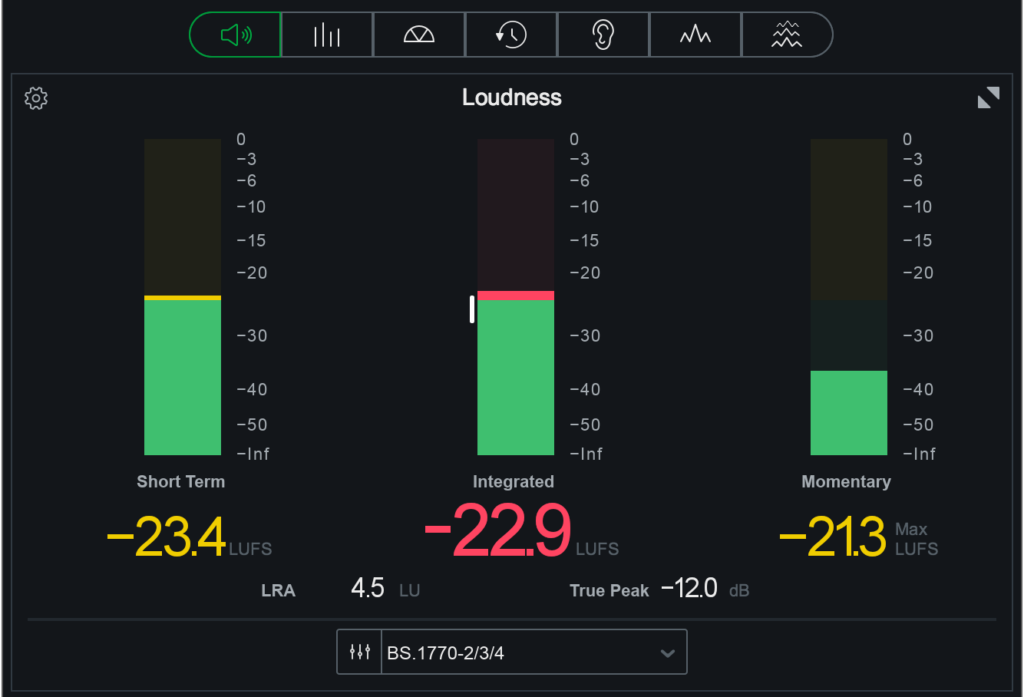
Izotope Meter Plugin
Analyzing the Impact of LUFS on Audience Perception
Following the alterations, a qualitative survey showed that the audience experienced a richer, fuller sound. The listeners reported a stronger connection with the music, attributing it to what they perceived as a more pronounced beat and enhanced clarity of lyrics post-LUFS improvement. This observation supports the theory that an optimal loudness level can indeed make a significant impact on audience engagement—a critical consideration for any mastering engineer.
| Attribute | Before LUFS Adjustment | After LUFS Adjustment |
|---|---|---|
| Integrated LUFS Level | -14 LUFS | -16 LUFS |
| Audience Engagement | Lower | Higher |
| Perceived Sound Quality | Good | Excellent |
| Streaming Platform Compliance | Non-Optimal | Optimal |
| Mastering Dynamics | Preserved | Preserved |
The evidence gathered through this LUFS case study solidified my understanding of the importance of deliberate loudness adjustment in audio mastering. It provided tangible proof that careful LUFS calibration does not only meet the technical demands of music distribution platforms but also fulfills the subjective expectations of the audience, enhancing their listening experience and potentially their emotional resonance with the music.
Conclusion
Throughout our exploration of LUFS in audio mastering, we’ve uncovered the integral role they play in ensuring our audio meets modern standards of quality and uniformity. As we have seen, mastering with LUFS in mind isn’t just a technical necessity; it’s an art that balances science with the listener’s experience. Integrating the knowledge and application of LUFS empowers mastering engineers to produce sound that both resonates with the audience and stands up to the demands of varying playback systems.
Summarizing the Importance of LUFS in Audio Mastering
The journey through the nuances of LUFS has highlighted their importance as an anchor in the vast sea of audio mastering. The insights gleaned from their application, from ensuring consistency across platforms to preserving the dynamic expression of a musical piece, demonstrate that understanding LUFS is not merely beneficial but essential. This mastery of LUFS conclusion not only brings our tracks to competitive loudness levels but also retains the creative intent behind every beat.
Best Practices for Mastering with LUFS in Mind
Concluding on mastering best practices, I emphasize the necessity of a meticulous and informed approach. Adhering to industry standards while not losing sight of the music’s dynamic range requires a fine-tuned ear and a comprehensive understanding of LUFS. It is this blend of technical precision and artistic sensitivity that makes for a masterfully crafted audio track, one that resonates equally through headphones, car speakers, and festival sound systems. Remember, the mastery of audio is in finding harmony between loudness and the ebb and flow of dynamics, ensuring each track reaches its highest potential.
If you’re looking for professional mixing or mastering services, visit mixandmastermysong.com. You’ll also find presets and courses tailored to enhance your music production journey. Stay tuned for more insights and discussions soon!
FAQ
What are LUFS in audio mastering?
LUFS, which stand for Loudness Units Full Scale, are a standardised measurement of audio volume levels that play a crucial role in mastering. They help ensure that audio tracks have consistent perceived loudness, which is important for listener experience across various platforms and playback systems.
How does mastering loudness impact the listener’s experience?
Mastering to the appropriate loudness impacts listener experience by ensuring the audio is heard as intended, regardless of the listening environment. It can affect the emotional impact, intelligibility, and overall satisfaction with the music or audio content.
What led to the introduction of audio loudness standards?
The ‘loudness wars’ – a trend of increasing audio levels in music to make tracks stand out – led to the introduction of loudness standards. These standards were implemented to maintain dynamic range and ensure a more consistent listening experience across different media.
What’s the difference between LUFS and dB?
LUFS and dB (decibels) are both units of measurement for sound, but they serve different purposes. dB measures the intensity of sound, while LUFS measure perceived loudness over time, taking into account human hearing sensibility.
Why do streaming services use loudness normalization?
Streaming services use loudness normalization to ensure a consistent listening experience. By standardizing the loudness levels of all the tracks, listeners can enjoy a seamless transition between songs without having to adjust the volume.
How many LUFS should my master be for different streaming platforms?
The target LUFS level for your master will depend on the platform. For instance, Spotify recommends mastering at approximately -14 LUFS, while Apple Music’s Sound Check prefers around -16 LUFS. However, it’s important to check each platform’s guidelines as they may update their loudness standards.
What balance should I find between dynamics and loudness?
Achieving a balance between dynamics and loudness is essential. While you want your track to be competitively loud, preserving dynamic range is key for maintaining audio quality and emotional impact. Striking this balance will vary from genre to genre and project to project.
What are the types of LUFS meters and why are they important?
There are various types of LUFS meters, including standalone hardware units, software plugins, and features integrated into digital audio workstations. They are essential for measuring the loudness of audio material accurately, ensuring compliance with broadcast standards, and achieving consistency across multiple tracks.
What LUFS should I master my music to?
The LUFS you should master your music to depend on the distribution platform, the genre, and your artistic intent. Generally, mastering to a loudness level of around -14 to -16 LUFS is a safe bet for most streaming services. Still, you’ll need to consider the dynamic range and the intensity you desire for your music.
What are common misconceptions about LUFS in mastering?
A prevalent misconception is that louder tracks are always better (the “louder is better” myth), which can lead to over-compression and a loss of dynamics. Also, some believe LUFS are the only important metric in mastering, overlooking factors such as frequency balance, stereo imaging, and distortion.
How can I set LUFS targets for different music genres?
When setting LUFS targets for different genres, consider the energy and dynamics typical for each style. For example, loudness levels for rock music may be higher than for acoustic jazz. Research industry standards for your genre and use a LUFS meter to tweak your master accordingly.
How do adjustments in LUFS affect audience perception?
Adjusting LUFS levels can significantly impact audience perception by altering the volume consistency and dynamic expression of a track. Proper loudness levels can enhance clarity and presence, while overcompression can make a track sound fatiguing and limit its emotional impact.

